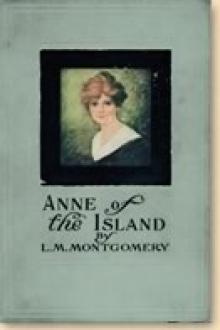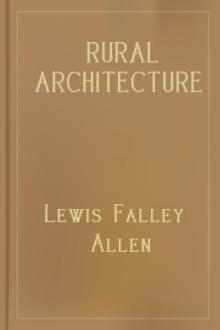A History of Art for Beginners and Students, Clara Erskine Clement Waters [best beach reads .txt] 📗

- Author: Clara Erskine Clement Waters
- Performer: -
Book online «A History of Art for Beginners and Students, Clara Erskine Clement Waters [best beach reads .txt] 📗». Author Clara Erskine Clement Waters
One of the most celebrated of Turner’s pictures was that of the “Old Téméraire,” an old and famous line-of-battle ship, which in the battle of Trafalgar ran in between and captured the French frigates Redoubtable and Fougueux. Turner saw the Téméraire in the Thames after she had become old, and was condemned to be dismantled. The scene is laid at sunset, when the smouldering, red light is vividly reflected on the river, and contrasts with the quiet, gray and pearly tints about the low-hung moon. The majestic old ship looms up through these changing lights, bathed in splendor. The artist refused a large price for this picture by Mr. Lennox, of New York, and finally bequeathed it to the nation. In 1840 Turner exhibited the “Bacchus and Ariadne,” two marine scenes, and two views in Venice; also the well-known “Slavers Throwing Overboard the Dead and Dying, a Typhoon Coming On” (Fig. 76), which is now in the Museum of Fine Arts of Boston. Of this picture Thackeray says: “I don’t know whether it is sublime or ridiculous.” But Ruskin, in “Modern Painters,” says: “I believe if I were reduced to test Turner’s immortality upon any single work, I should choose the ‘Slave Ship.’ Its daring conception, ideal in the highest sense of the word, is based on the purest truth, and wrought out with the concentrated knowledge of a life. Its color is absolutely perfect, not one false or morbid hue in any part or line, and so modulated that every square inch of canvas is a perfect composition; its drawing as accurate as fearless; the ship buoyant, bending, and full of motion; its tones as true as they are wonderful; and the whole picture dedicated to the most sublime of subjects and impressions (completing thus the perfect system of all truth which we have shown to be formed by Turner’s works), the power, majesty, and deathfulness of the open, deep, illimitable sea.”
No painter of modern times, or perhaps of any time, has ever provoked the discussion of his merits which Turner did. When he was at his best his great merits and his originality procured for him the strongest defenders, and finally brought his pictures into favor with the wealthy middle class of England, so that he obtained high prices, and since his death these prices have doubled, and even quadrupled. At a sale of Mr. Bicknell’s collection in 1836, ten of Turner’s pictures, which had been bought for three thousand seven hundred and forty-nine pounds, were sold for seventeen thousand and ninety-four pounds. As Turner grew older and his manner deteriorated he was assailed by the wits, the art critics, and the amateurs with cruel badinage, and to these censures Turner was morbidly sensitive. But even Ruskin admits that the pictures of his last five years are of “wholly inferior value,” with unsatisfactory foliage, chalky faces, and general indications of feebleness of hand.
Wornum, in his Epochs of Painting, said: “In the last ten years of his career, and occasionally before, Turner was extravagant to an extreme degree; he played equally with nature and with his colors. Light, with all its prismatic varieties, seems to have been the chief object of his studies; individuality of form or color he was wholly indifferent to. The looseness of execution in his latest works has not even the apology of having been attempted on scientific principles; he did not work upon a particular point of a picture as a focus and leave the rest obscure, as a foil to enhance it, on a principle of unity; on the contrary, all is equally obscure and wild alike. These last productions are a calamity to his reputation; yet we may, perhaps, safely assert that since Rembrandt there has been no painter of such originality and power as Turner.” Dr. Waagen says in his Treasury of Art in Great Britain: “No landscape painter has yet appeared with such versatility of talent. His historical landscapes exhibit the most exquisite feeling for beauty of hues and effect of lighting, at the same time that he has the power of making them express the most varied moods of nature.”
Toward the last part of his life Turner’s peculiarities increased; he became more morose, more jealous. He was always unwilling to have even his most intimate friends visit his studio, but he finally withdrew from his own house and home. Of late years he had frequently left his house for months at a time, and secreted himself in some distant quarter, taking care that he should not be followed or known. When the great Exhibition of 1851 opened, Turner left orders with his housekeeper that no one should be admitted to see his pictures. For twenty years the rain had been streaming in upon them through the leaky roof, and many were hopelessly ruined. He sent no pictures to the exhibition of that year, and he was hardly to be recognized when he appeared in the gallery. Finally his prolonged absence from the Academy meetings alarmed his friends; but no one dared seek him out. His housekeeper alone, of all that had known him, had the interest to hunt up the old artist. Taking a hint from a letter in one of his coats, she went to Chelsea, and, after careful search, found his hiding-place, with but one more day of life in him. It is said that, feeling the need of purer air than that of Queen Anne Street, he went out to Chelsea and found an eligible, little cottage by the side of the river, with a railed-in roof whence he could observe the sky. The landlady demanded references from the shabby, old man, when he testily replied, “My good woman, I’ll buy the house outright.” She then demanded his name—“in case, sir, any gentleman should call, you know.” “Name?” said he, “what’s your name?” “My name is Mrs. Booth.” “Then I am Mr. Booth.” And so he was known, the boys along the river-side calling him “Puggy Booth,” and the tradesmen “Admiral Booth,” the theory being that he was an old admiral in reduced circumstances. In a low studded, attic room, poorly furnished, with a single roof window, the great artist was found in his mortal sickness. He sent for his favorite doctor from Margate, who frankly told him that death was at hand. “Go down stairs,” exclaimed Turner, “take a glass of sherry, and then look at me again.” But no stimulant could change the verdict of the physician. An hour before he died he was wheeled to the window for a last look at the Thames, bathed in sunshine and dotted with sails. Up to the last sickness the lonely, old man rose at daybreak to watch, from the roof of the cottage, the sun rise and the purple flush of the coming day. The funeral, from the house in Queen Anne Street, was imposing, with a long line of carriages, and conducted with the ritual of the English Church in St. Paul’s Cathedral. Dean Milman read the service, and at its conclusion the coffin was borne to the catacombs, and placed between the tombs of James Barry and Sir Joshua Reynolds. Turner’s will, with its codicils, was so confused and vague that the lawyers fought it in the courts for four years, and it was finally settled by compromise. The real estate went to the heir-at-law, the pictures and drawings to the National Gallery, one thousand pounds for a monument in St. Paul’s Cathedral, and twenty thousand pounds to the Royal Academy for annuities to poor artists. Turner’s gift to the British nation included ninety-eight finished paintings and two hundred and seventy pictures in various stages of progress. Ruskin, while arranging and classifying Turner’s drawings, found more than nineteen thousand sketches and fragments by the master’s hand, some covered with the dust of thirty years.
Sir David Wilkie (1785-1841) has been called the “prince of British genre painters.” His father was a minister, and David was placed in the Trustees’ Academy in Edinburgh in 1799. In 1805 he entered the Royal Academy in London, and was much noticed on account of his “Village Politicians,” exhibited the next year. From this time his fame and popularity were established, and each new work was simply a new triumph for him. The “Card Players,” “Rent Day,” the “Village Festival,” and others were rapidly painted and exhibited.
In 1825 Wilkie went to the Continent, and remained three years. He visited France, Germany, Italy, and Spain, and after his return he painted a new class of subjects in a new manner. He made many portraits, and his other works were historical subjects. His most celebrated works in this second manner were “John Knox Preaching,” “Napoleon and the Pope at Fontainebleau,” and “Peep-o’-Day Boy’s Cabin.” The portrait of the landscape painter William Daniell is a good picture.
In 1830 Wilkie succeeded Sir Thomas Lawrence as painter to the king, as he had been limner to the King of Scotland since 1822. He was not knighted until 1836. In 1840 he visited Constantinople, and made a portrait of the sultan; he went then to the Holy Land and Egypt. While at Alexandria, on his way home, Wilkie complained of illness, and on shipboard, off Gibraltar, he died, and was buried at sea. This burial is the subject of one of Turner’s pictures, and is now in the National Gallery.
The name of Landseer is an important one in British art. John Landseer (1761-1852) was an eminent engraver; his son Thomas (1795-1880) followed the profession of his father and arrived at great celebrity in it. Charles, born in 1799, another son of John Landseer, became a painter and devoted himself to a sort of historical genre line of subjects, such as “Cromwell at the House of Sir Walter Stewart in 1651,” “Surrender of Arundel Castle in 1643,” and various others of a like nature. Charles Landseer travelled in Portugal and Brazil when a young man; he was made a member of the Royal Academy in 1845; from 1851 to 1871 he was keeper of the Academy, and has been an industrious and respected artist. But the great genius of the family was:
Sir Edwin Landseer (1802-1873), the youngest son of John Landseer, the engraver. He received his first drawing lessons from his father, and from a very early age showed a great talent for sketching and that love for the brute creation which have been his chief characteristics as an artist. He had the power to understand his dumb subjects as well as if they spoke some language together, and then he had the ability to fix the meaning of all they had told him upon his canvas, by means of the sketching lines which gave the precise form of it all and by his finishing shades which put in the expression. If his animals were prosperous and gladsome, he represented their good fortune with hearty pleasure; if they were suffering, sad, or bereaved, he painted their woes with a sympathy such as none but a true friend can give.
When Edwin and Thomas were old enough that their father thought other instruction than his own should be given them, he placed them with Haydon, and in these early days the master predicted that Edwin Landseer would be the Snyders of England. Edwin sent his first picture to the Royal Academy when he was but thirteen years old, and during the following fifty-eight years there were but





Comments (0)